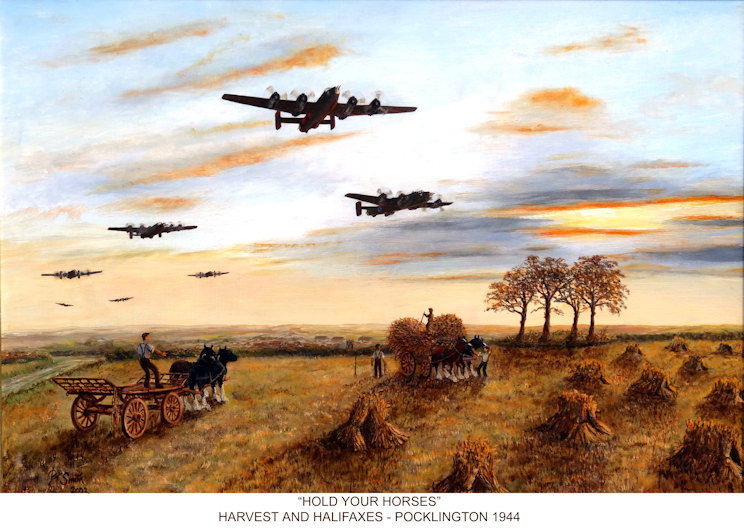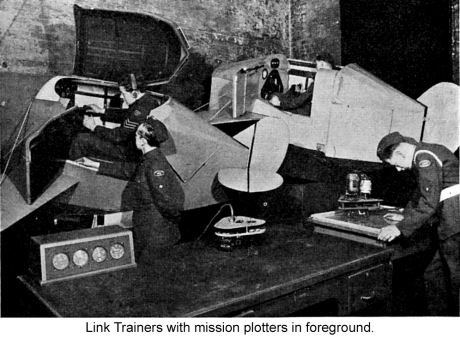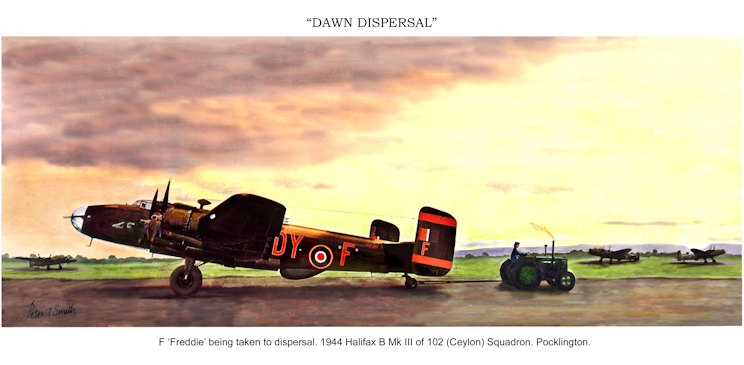I am just old enough to remember the Halifax bombers at Pocklington in their final years of operation at the end of WWII. The fact that the airfield shared a common boundary with the Pocklington school playing fields must have caused them a few distractions during cricket and rugby matches in the war years. Many of the aircrew were little older than the boys playing sports on the other side of the hedge. My most vivid memories were of travelling in my fathers car on the York-Hull road and being stopped by by RAF personnel to allow the Halifax bombers to be towed across the road to and from the 'Frying Pan' hard standings on the Allerthorpe side. The incredible sight of a little tractor pulling these massive machines left a lasting memory. Up to that point the largest thing I had seen a tractor pull on the farm at home was a trailer load of hay or straw.

An original painting by Peter Smith depicting his memories of Mk.III Halifax bombers of 102 (Ceylon) Squadron leaving Pocklington airfield to rendezvous with others over the East Yorkshire coast before setting out for a raid over Germany in early September 1944. Pocklington was sending up to 25 bombers per mission at this time, many of them daylight raids. The plain of York stretches away in the distance with Pocklington church tower directly in line with hangers on the airfield. The clump of trees on a Bronze Age burial mound form one of the highest points on the Yorkshire Wolds at 204m (670ft) a local landmark. A full load of wheat sheaves is about to be roped when the aircraft are heard approaching. The replacement empty cart is arriving from nearby Newcote farmstead on the Warter Estate. During this period of fuel shortages horses were particularly suited to short haul carting of sheaves. Low flying aircraft were apt to startle blinkered horses, even causing a stampede, so that both pairs are being restrained. The painting illustrates 45,224 horse power, only four of which are on the ground!
A few years later as a cub at school, we were taken out on a visit Full Sutton Airfield which at that time, in 1951 was an Advanced Refresher Training School for pilots. We "had a go" in a Link Trainer used to train pilots in navigation, an early forerunner of the flight simulator. We were also asked for volunteers to have a ride in a Hurricane, sitting on the pilot's lap as he revved the engine, taxied a short distance along the runway, turned and taxied back towards the eagerly awaiting passengers. Today it would no doubt be considered dangerous and politically incorrect on serveral counts!

We were also invited to board an Airspeed Oxford twin engined trainer, sitting on the floor, the engines revving to what seemed like full power, deafening and shaking us violently in what was essentially a large tin can. These early experiences kindled in me a lifelong interest in all things aeronautical and an admiration for the aircrews who manned these primitive machines.
On hearing of the Flying Man Festival - a commemoration of one man dying on the church tower in an attempt to "fly" down a rope and entertain, prompted me to think of the nine hundered and twenty two aircrew who died in operations from Pocklington and the fact that these sacrifices and the feats of the survivors were never acknowledged by the authorities after the war as in the other services. This omission was only belatedly rectified in June 2012 when the memorial to bomber command was unveiled by the Queen in Green Park London. Pocklington paid a high price as did Bomber Command in general with 55,573 fatalities.

The rising sun is breaking the outline of the hilltops of the Yorkshire Wolds in the distance to the east of Pocklington. The watercolour painting by Peter Smith depicts a Halifax B Mk 3 bomber being towed by a small tractor from his personal memory recollection of seeing the sight at Pocklington Airfield in 1944.
Peter Smith
22nd July 2013
|

